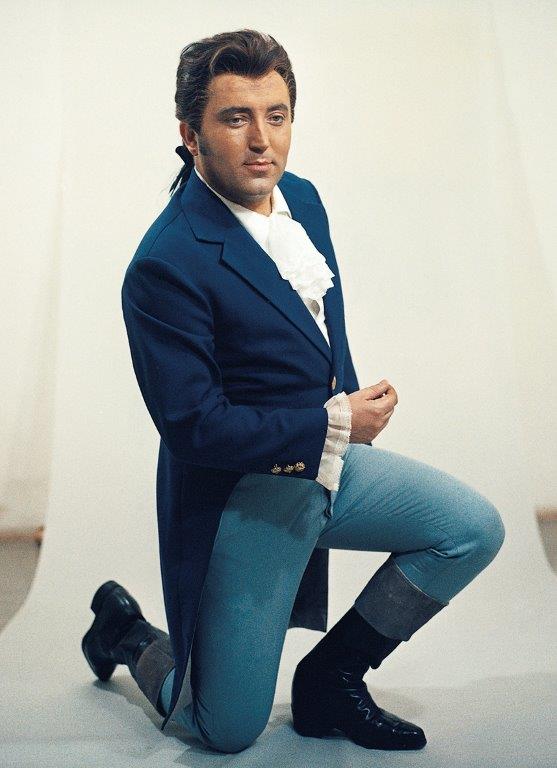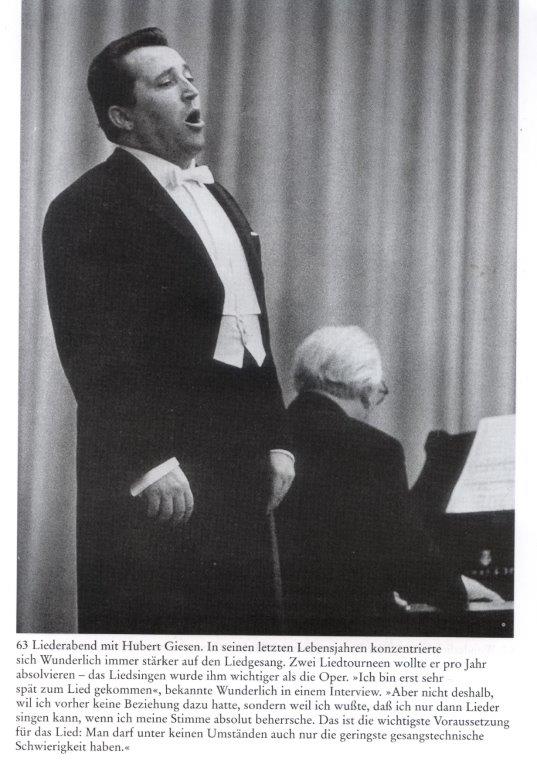Continued from part two
At the end of January 1960, Fritz Wunderlich met Herbert von Karajan for the first time: in a performance of Mozart’s Requiem with the Berlin Philharmonic Orchestra, Wunderlich earned the praise of the Berlin press: “Only one voice rises as the spokesman for Mozart and his moving farewell song: Fritz Wunderlich’s lyrical tenor, with whom none of the other soloists can compete in terms of culture, musicality and fulfillment of the performance (…)” read a review in the Kurier.
Wunderlich: synonymous with a profession
Von Karajan and Wunderlich met again at the Salzburg Festival in 1960 – Mozart’s Requiem was also performed here.
In the same year, several recordings were scheduled: Fritz Wunderlich had long since become a demanded artist of his time. Even people who were not opera lovers could relate to the name Fritz Wunderlich. The tenor from Kusel was about to become synonymous with his profession – and far beyond the borders of Europe…
Guest performance in South America
In September and October 1961, Fritz Wunderlich embarked on a journey to Buenos Aires: under the baton of Heinz Wallberg, The Abduction from the Seraglio (Mozart), Die schweigsame Frau [The silent woman] (Richard Strauss) and The Knight of the Rose (Strauss) were performed at the Teatro Colón. Kurt Böhme as Sir Morosus in Die schweigsame Frau and Anneliese Rothenberger as Konstanze in Die Entführung aus dem Serail accompanied Wunderlich to South America.
The South American guest performance familiarized Wunderlich with a completely different world: some of the operas and Singspiele had never been performed in Argentina before. Fritz Wunderlich was given the honor of setting standards, especially through his interpretation of Henry Morosus in Die schweigsame Frau – for no opera lover in Argentina had ever heard this role before.

First Lieder recital in Vienna
Fritz Wunderlich’s second great career began in February 1962: he gave his first Lieder recital in Vienna. Although many opera performers were and are successful Lieder performers, the two genres differ: an opera performance in which a singer sings the lead role offers the luxury of spending a lot of time on stage. Thus, the singer has more time to prove himself to the audience. A Lied, on the other hand, is much shorter, often comprising only a few sheets of music, but it requires just as much creative power from the performer as an operatic performance.
Continuing on the chosen path…
Wunderlich’s first Lieder recital received a mixed reception: “It was as if he was afraid that he might be accused of confusing the concert stage with the opera stage,” said one press commentator. The well-known Austrian critic Karl Löbl, on the other hand, was convinced of Wunderlich’s qualities from the very beginning: “A Lieder singer was discovered that evening. The great, honest success may be an incentive for Mr. Wunderlich to continue on his chosen path.”
To continue on the chosen path: That was exactly what Fritz Wunderlich had in mind.
First, however, other obligations had priority …
Quality over quantity
In 1962 Wunderlich was offered the opportunity to participate in a recording of Così fan tutte (Mozart): Peruvian tenor Luigi Alva had canceled for the role of Ferrando, so Fritz was asked if he would take the part. Elisabeth Schwarzkopf, Christa Ludwig and Karl Böhm were to take part. The only difficulty: Wunderlich had only eight days to rehearse the part. So far, he had sung Ferrando only in German, but the recording was planned in Italian.
Wunderlich canceled: He could have rehearsed the role within eight days, but not at the high artistic level to which he was committed. For Fritz, artistic quality had absolute priority over financial interests and pressure from record companies to make as many records as possible. Although for Wunderlich the number of recordings took a back seat, his discography includes several hundred recordings.
Second Lieder recital
The year 1963 was a decisive one in Wunderlich’s career: in March 1963 Wunderlich gave a second Lieder recital in Munich (he had given his first one a year earlier). This evening was again received rather reservedly by the critics: Many still had a hard time with the fact that the lyric opera tenor Fritz Wunderlich was now also advancing to a Lieder singer.
In a way, it was the return of an experience from his student years: Back then, some could not accept the fact that Fritz covered different musical genres.

Wunderlich and Hubert Giesen
Instead of being discouraged, he worked on his Lieder singing and, more importantly, he looked for a mentor who would also accompany him on the piano during his Lieder recitals.
The choice fell on Professor Hubert Giesen from Stuttgart: the two began work on Schumann’s Dichterliebe [A Poet’s Love] with music by Robert Schumann and texts by Heinrich Heine.
When singing Lieder, a singer is often faced with the question of whether to follow the composer’s interpretation of the text or to interpret the poet’s text.
Giesen and Wunderlich worked to find the balance and allow both composer and poet to have their say in the interpretation.
On May 26, 1963, Wunderlich was ready after weeks of work with Hubert Giesen: he gave a Lieder recital at the Theater an der Wien, including a performance of Dichterliebe. The press response was euphoric, Wunderlich’s new approach impressed the critics: the work with Hubert Giesen had paid off. This brought Fritz Wunderlich’s second career on its way: his career as a Lieder singer…
Cover picture: Fritz Wunderlich as Belmonte, by courtesy of the Fritz Wunderlich Society
The main source is the Fritz Wunderlich biography by Werner Pfister (new edition 2005 by Schott Musikverlag)
Der Bussard would like to thank the Fritz Wunderlich Society for their support.

 Deutsch
Deutsch